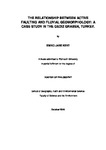The relationship between active faulting and fluvial geomorphology: a case study in the Gediz Graben, Turkey.
| dc.contributor.supervisor | Boulton, Sarah | |
| dc.contributor.author | Kent, Emiko Jane | |
| dc.contributor.other | School of Geography, Earth and Environmental Sciences | en_US |
| dc.date.accessioned | 2016-01-28T17:15:19Z | |
| dc.date.available | 2016-01-28T17:15:19Z | |
| dc.date.issued | 2015 | |
| dc.date.issued | 2015 | |
| dc.identifier | 231349 | en_US |
| dc.identifier.uri | http://hdl.handle.net/10026.1/4253 | |
| dc.description.abstract |
Identifying tectonically active faults and quantifying rates of movement is a key challenge in the Earth Sciences, in addition to this the interactions between active faulting and the landscape, specifically involving the fluvial network, is a relatively new area of study. Previous work has highlighted the value of understanding how the fluvial network responds to active tectonics, showing that a comprehensive understanding of the dynamic relationship between fluvial geomorphology and active tectonics is an important next step in geological research. This study presents new information about the poorly constrained Quaternary tectonic history of the Gediz Graben, Turkey, providing the first quantification of rates of movement of the key fault array that presently controlling graben topography. The fluvial network has been investigated and the data has been used in order to add resolution to the tectonic history for the fault array, allowing for the quantification of post-linkage throw rates. The study then investigates the key controls on the behaviour of the fluvial network that cross the active topography building fault array in the Gediz Graben. This study shows that there has been a linkage event occurring between 0.6 – 1 Ma, involving the three segments of the graben bounding fault array. The pre- and post-linkage throw rates are then extrapolated using data derived from the fluvial network, showing a faulting enhancement factor of 3 at the centre of the fault array, with the throw rate at the centre of the array predicted to have increased from a pre-linkage rate of 0.6 ± 0.1 mm/yr to a rate of 2 ± 0.2 mm/yr. This research provides evidence that the fluvial network can be used in conjunction with other types of evidence to provide a greater resolution tectonic history. Using both digital data and field studies this research presents an examination of the factors that influence the behaviour of bedrock rivers undergoing perturbation due to tectonics. Factors such as drainage area, tectonic throw rates and lithology have been investigated and the complicated interactions of these variables with the fluvial system have been quantified. This study shows that the bedrock rivers are a significant source of information about tectonics, but further work is needed to resolve quantitatively how various factors influence how rivers adjust to tectonic perturbation, in a variety of tectonic situations, in order to enable river to be used as a primary tool for deriving information about tectonics. | en_US |
| dc.language.iso | en | en_US |
| dc.publisher | Plymouth University | en_US |
| dc.subject | Active tectonics | |
| dc.subject | Gediz Graben | |
| dc.subject | Knickpoints | |
| dc.subject | Channel geometry | |
| dc.subject | Fluvial geomorphology | en_US |
| dc.title | The relationship between active faulting and fluvial geomorphology: a case study in the Gediz Graben, Turkey. | en_US |
| dc.type | Thesis | |
| plymouth.version | Full version | en_US |
| dc.identifier.doi | http://dx.doi.org/10.24382/4182 |
Files in this item
This item appears in the following Collection(s)
-
01 Research Theses Main Collection
Research Theses Main


